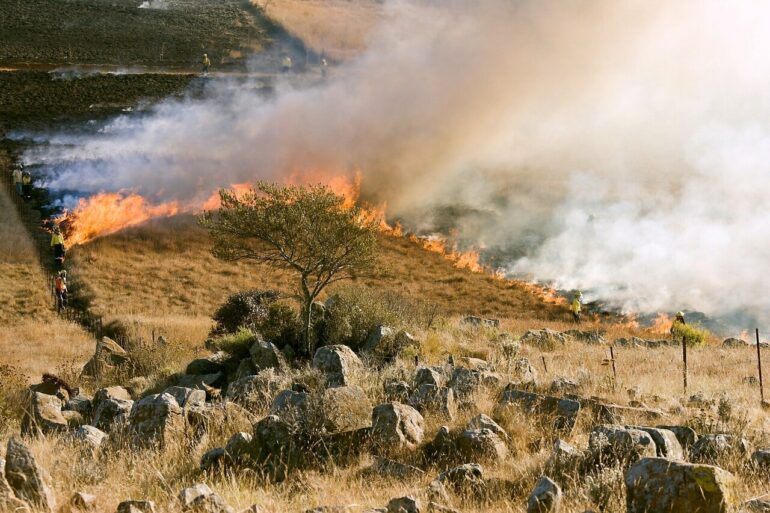Take a seat, chin to the sky. Insert the swab, rotate slowly and switch nostrils—we know the drill. Only this time, it’s not a COVID-19 test. And the nose is attached to a monkey.
Three years ago, researchers in Davis swabbed the nasal cavities of 22 captive rhesus macaque monkeys that were born just before and after the horrific 2008 wildfire season. Alterations in their DNA showed, for the first time, that exposure to wildfire smoke can create long-term changes in the way that genes are expressed in primates, they reported in January.
It’s unknown whether the same results will be found in humans, and follow-up studies are underway. But the DNA modifications suggest that like the monkeys, young people breathing in orange skies may be more susceptible to respiratory illness and brain development issues later in life. Such studies of the long-term health effects could also open the door for future treatments to mitigate the damage of smoke, which poses a growing threat as the state experiences more frequent and toxic wildfires.
For years, scientists have associated the particulate matter from smoke with respiratory health complications such as COPD and asthma—particularly in children.
“We know air pollution is bad, but we don’t know the specific regions (of the DNA) that it’s targeting,” said Juan Aguilera, a physician-scientist at Stanford University who was not affiliated with the research. “There’s been, also, a need to know more about the long-term effects of the exposure.”
The new study out of Davis addresses both of these gaps—identifying individual pathways by which smoke exposure impacts the body, and following those changes over time. To do so, researchers are looking to the epigenome: the layer of molecules on top of genetic code that dictates how DNA is interpreted, helping turn specific genes on and off.
“We’re talking about a genetic component that basically tells the cells how to act and what to do,” Aguilera explains. “Epigenetics studies how the environment and external exposures change our bodies and how our bodies work.”
When Hong Ji and her colleagues from the California National Primate Research Center at UC Davis looked at the monkeys’ nasal DNA, they were surprised to find that over 3,000 regions in the epigenome were different for monkeys that were exposed to the 2008 wildfires and those that weren’t.
“I thought we’d be lucky to see something, but wow. … There’s these unappreciated, huge, massive changes across the genome that people did not realize,” Ji said.
Some of the impacted regions deal with genes typically involved in immune response and neural development, meaning that smoke exposure could impact breathing and cognition in the long run. In fact, the researchers already showed that the monkeys born after the wildfires had reduced lung capacity and impaired lung function. The team is currently looking for signs of brain damage in the exposed monkeys, but previous studies have linked air pollution to autism and other neurodevelopmental disorders.
“Your body actually has the memory of previous exposures stored in the epigenome—the mark is always there,” Ji said. “That memory could change the way you respond to infections or allergens or viruses.”
These findings add to growing concerns for the dangers of inhaling wildfire smoke—particularly at a young age, when individuals haven’t yet developed sufficient protection.
The researchers said they expect to see similar epigenetic effects in people. Ji is teaming up with Rebecca Schmidt at UC Davis to repeat the study in pregnant mothers and young children, and they’re in the process of recruiting participants now.
This time, however, the scientists are focusing on more recent fires. Most studies investigating the health effects of wildfires have been set at or before the 2008 wildfire season, which followed three year extremely dry conditions and burned more nearly 1.6 million acres. Still, “The exposure that year is pretty small—a blip compared to these more recent years,” Schmidt said.
Keith Bauer, another researcher at UC Davis, has tracked the chemical composition of wildfires over time with a rapid-response mobile research unit he built to vacuum smoke from the air and analyze the particulate matter. As humans have developed more of the rural landscape, fires have begun to consume structures and electronics, releasing new and unknown chemicals into the air, he said.
“There’s a new generation of wildfires we’re seeing,” Bauer said. “The composition looks radically different in some of these wildfires where the built environment is involved in the fuel.”
The fact that wildfires are getting worse over time makes the newly identified long-term epigenetic effects even more daunting. Scientists recommend evacuating polluted areas, wearing protective N-95 masks and using air filters whenever possible, but they recognize that not everyone has the financial means to do so.
“We need to do a better job protecting ourselves—not only on a personal level, but also through policy and inter-community behaviors,” Aguilera said.
The new research into epigenetic smoke effects may provide a beacon of hope, though a distant one.
“Knowing where the specific changes occur at the genetic level might be the way to look into therapies, or even some sort of medication,” Aguilera said. “I think they’re going in a great direction.”
2022 The Mercury News (San Jose, Calif.). Distributed by Tribune Content Agency, LLC.
Citation:
Exposure to wildfire smoke linked to altered DNA structure in monkeys (2022, March 8)



